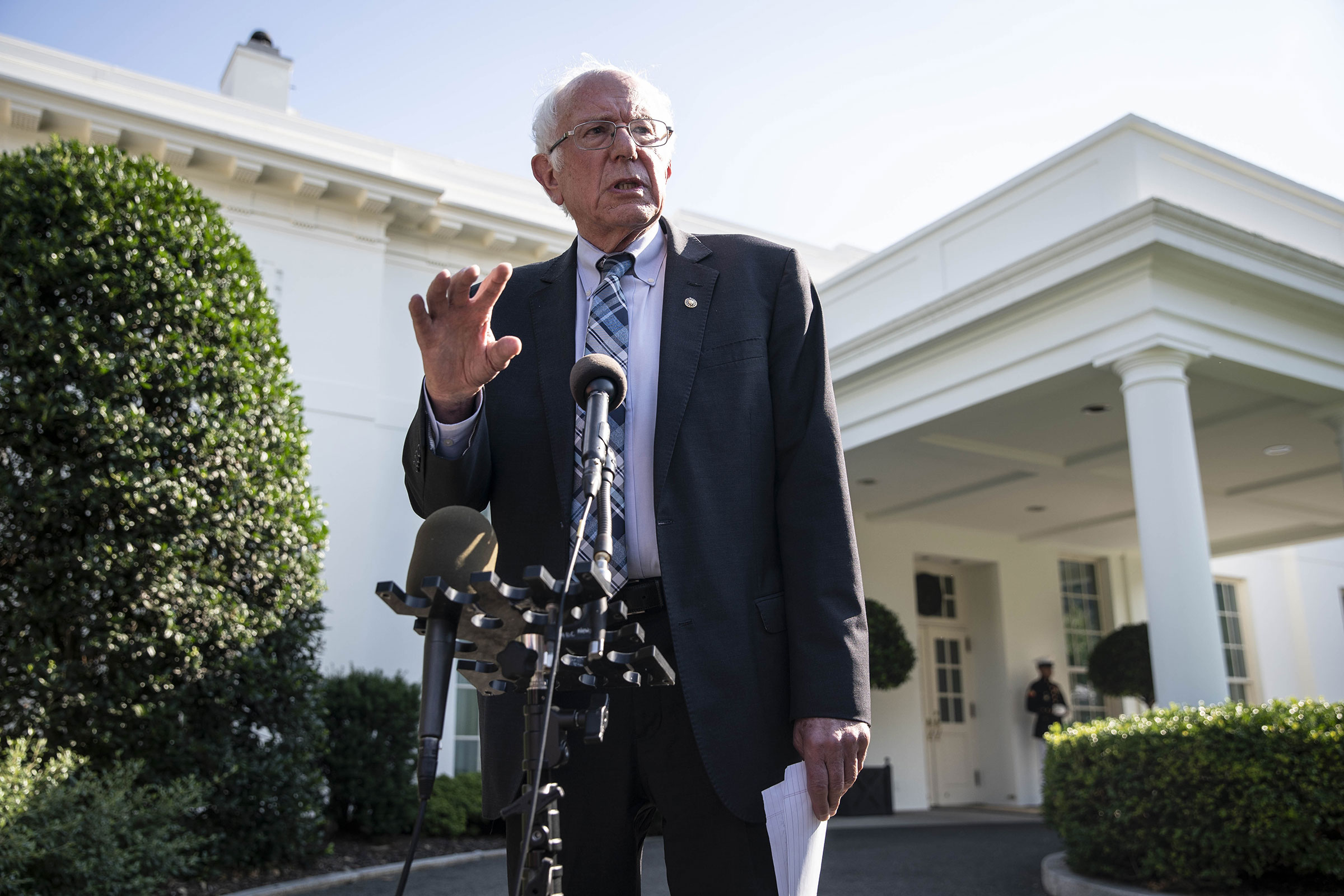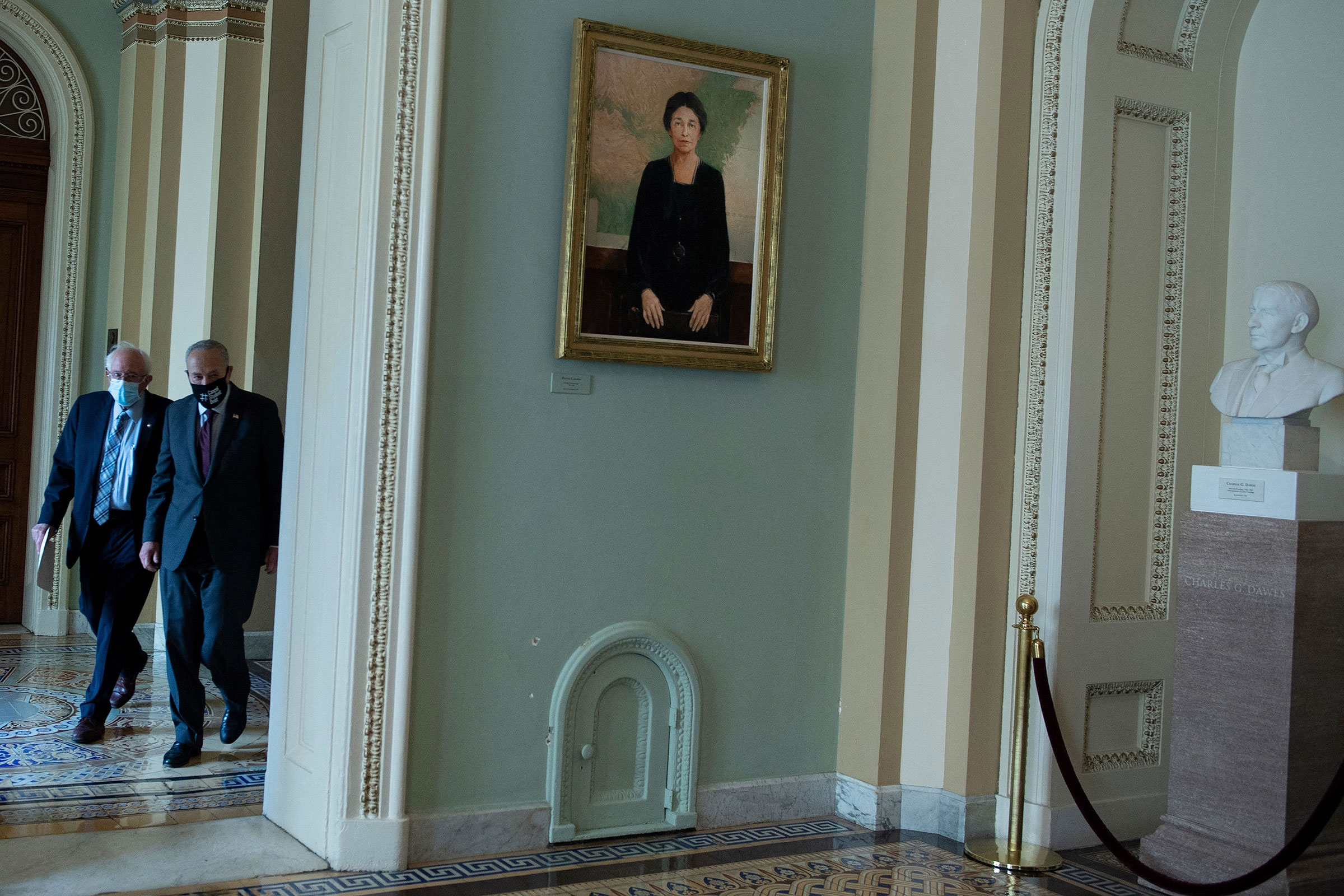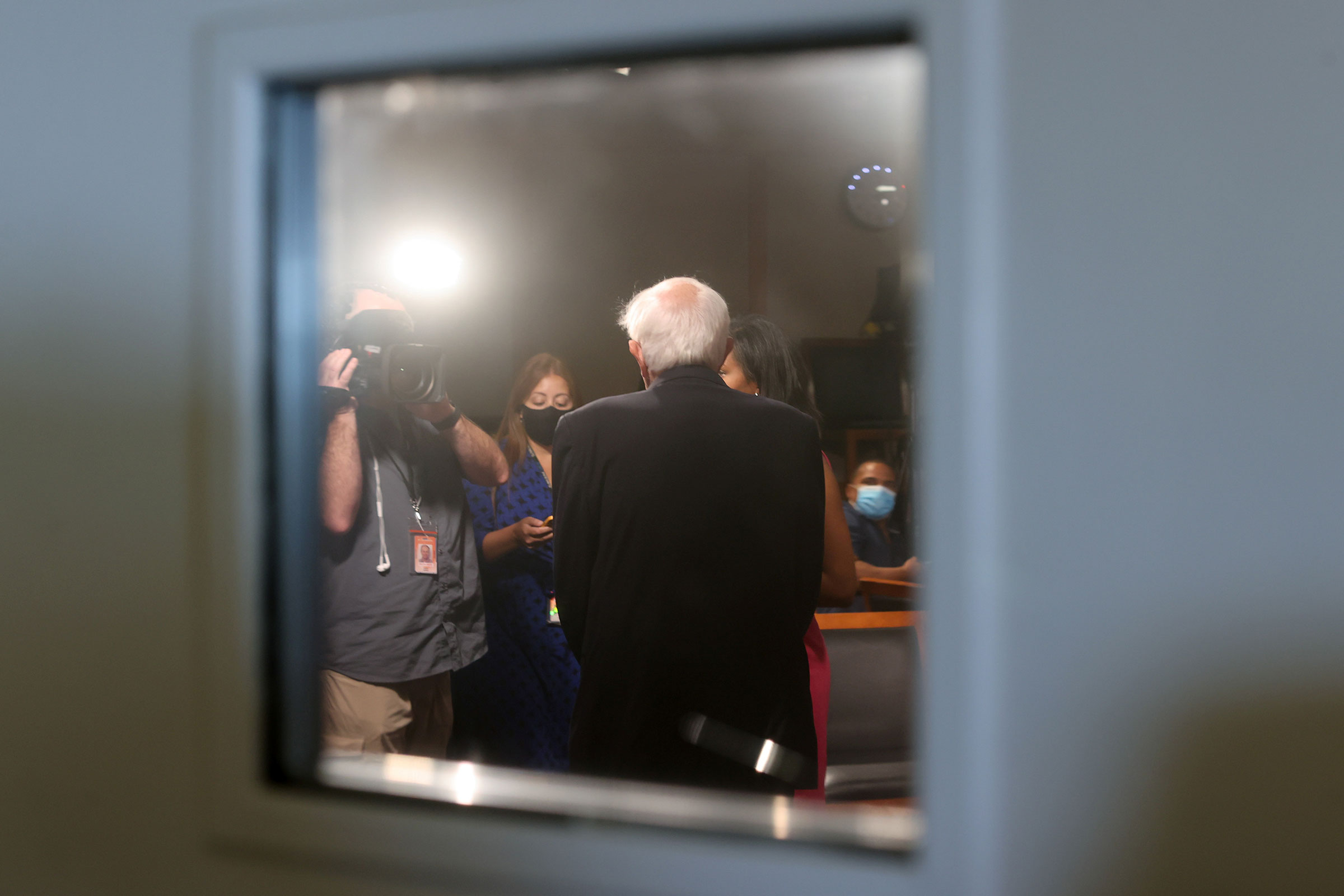
On a sticky late August afternoon, Senator Bernie Sanders takes the stage in the state that catapulted him from fringe presidential candidate to progressive hero five years ago.
One need look no further than the masked audience members to see how much has changed since Sanders last campaigned in Iowa on his two presidential runs in 2016 and 2020. The event is outdoors, socially distanced and many in the crowd are wearing face coverings—a clear reminder of the coronavirus pandemic that ground the country to a halt a year and a half ago, killing more than 600,000 Americans and millions of jobs.
For Sanders, political opportunity has come from tragedy. The pandemic pushed both the country and the Democratic Party to embrace the Vermont Senator’s career-long push for government aid programs. President Joe Biden came into the Oval Office determined to prove that, in the depths of the pandemic and after the chaotic Trump Administration, the government could be a force for good. And when Democrats narrowly reclaimed the Senate last January, Sanders took over the powerful Senate Budget Committee and became a crucial partner to passing Biden’s objectives.
That’s what brought Sanders to Iowa this time around. He reached an agreement with Biden in July for a $3.5 trillion avalanche of federal spending over the next decade that would make childcare and community college more affordable, expand Medicare and authorize a federal paid family leave program—all largely paid for by taxing the wealthy and corporations. Now, he’s trying to sell the budget bill to the public. “We can not only address these awful problems,” he tells the crowd, “but we can move this country forward in a very different and positive direction.”

After three decades in Washington, Sanders is at the height of his powers, and on the cusp of delivering a version of the policies he’s advocated for his entire career. But in order to do that, one of the Senate’s oldest progressive agitators has relied on a timeless legislative skill rarely mentioned in his campaign speeches: compromise. While Sanders initially envisioned a $6 trillion spending bill, he settled for nearly half that in order to get all members of his party on board. “This is the most consequential piece of legislation for working people since the 1930s,” Sanders says in an interview with TIME at a diner in Cedar Rapids, banging his hand on the wooden picnic table between every word for emphasis. “If you’re a progressive who has spent your entire life fighting for working people, fighting for children, fighting for the elderly, fighting for the climate, what you say is, ‘Well, it’s not all that I want.’ We’ve got to continue the fight, but we have accomplished an enormous amount.’”
Progressives watching the process say he is teaching them how to govern, a lesson that could have a longer legacy than the bill. “It’s a necessary maturation of the progressive movement to go from protest to government,” says Joseph Geevarghese, the Executive Director of Our Revolution, a political grassroots organization that grew out of Sanders’ first presidential campaign. “And that’s the process that we’re in the middle of, is learning that we can’t just be outside on the streets raising hell.”
The $3.5 trillion package is far from a done deal, and Sanders will soon face the ultimate test. Committees in the House and Senate are currently drafting language, but with moderate lawmakers in both chambers skeptical of the price tag, it’s becoming increasingly clear that progressives are unlikely to get everything they want. There are weeks of intense negotiations ahead. But if Sanders can get a version of this bill to Biden’s desk, he will have played a key role in passing the most expensive reshaping of the country’s social safety net in over half a decade—and perhaps cemented his own legacy as both firebrand and legislator.
‘A lot of heartburn’
As soon as Biden introduced his blueprint for spending on infrastructure and the “care economy” last spring, Sanders began strategizing with progressives in Congress on how to maximize their leverage.
While Sanders wanted a $6 trillion bill, he knew it was unrealistic. He sensed from both his personal relationship with Biden and the policies the President was putting forward—like two years of free community college and universal access to pre-K—that he had a better chance of getting at least some of what he wanted if he was willing to come down on the price.

Throughout the spring, Sanders huddled with the leadership of the Congressional Progressive Caucus (CPC) to come up with their five top priorities: investments in home care services and affordable housing; lower drug prices and Medicare eligibility; and creation of climate jobs. Rep. Ilhan Omar of Minnesota, the whip of the CPC, recalls meeting with Sanders over a dozen times. “The dollar amounts were really not the focus of the conversation, but more in regards to getting… a bill that meets the moment, and making sure that the Progressive Caucus was using its influence,” she says.
Sanders also pressured the White House: In the Oval Office in July, he pushed Biden to include hearing aids, eyeglasses, and dental coverage in the Medicare expansion, and Biden agreed. “Though it was not in the original Families Plan announced in April, Senator Sanders repeatedly pressed the President to embrace his proposal to expand Medicare coverage for dental, hearing aids, and vision,” says a senior White House aide. “He made that case passionately, strongly in the Oval, and the President gave his full backing.”
Sanders’ strategy, says one Congressional aide familiar with the dynamics of progressive wing, was to “lay out a left flank marker that would then have gravity, and pull the debate to the left.” Progressives credit Sanders with getting what they so far view as a favorable compromise. “I don’t think we would have ended up with three and a half trillion,” the aide says, “If [Sanders] hadn’t done that.”

After weeks of negotiating with both the White House and his own committee, Sanders says the $3.5 trillion number was reached thanks to “a lot of talking and a lot of heartburn.” For him, it’s a mixed bag. Ideas he had been championing for years, like a wealth tax and Medicare for All, were not in there. But other progressive wish list items, like an extension of the child tax credit and tax increases on the wealthy, were included. “All of the major provisions remain in the bill: that is the good news,” he says. “The bad news is, we are not funding them, at this point, for as long a period as I want.”
‘We’ve got to be as pragmatic as possible’
Sanders acolytes hope his leadership will pave the way for the progressive movement to become an effective governing force, crafting legislation within the system rather than protesting outside it.
In July, Our Revolution, which according to a spokesperson has over 500,000 members organized in thirty states, rebranded itself as a group of “pragmatic progressives.” Instead of rallying around big ideas like the Green New Deal or Medicare for All, they will now advocate for more incremental changes. During the August recess, they demonstrated in front of moderate lawmakers’ offices—in favor of the $3.5 trillion package. “Our job as organizers is trying to educate people, like, ‘Look, we’ve got to be as pragmatic as possible,” says Geevarghese, the group’s Executive Director. Geevarghese largely credits Sanders with paving that path for the group. “What Bernie has done I think quite artfully as a movement leader is not just throw bombs or issue critiques, but actually get our ideas to be considered seriously and then make… pretty significant progress in advancing them,” he says.
In the coming weeks, that progress could slow. The committees tasked with drafting the components of the legislation have been working furiously to present a complete version for Congress to pass by the end of September at the earliest. Democrats are trying to pass it through a budgetary process called reconciliation, which they can do along party lines. But with such small margins in the House and Senate, and no support from Republicans, there is no room for any defections, and the moderate wing of the party is gearing up for a challenge. West Virginia Senator Joe Manchin has already said the price tag will be a problem. “I, for one, won’t support a $3.5 trillion bill, or anywhere near that level of additional spending, without greater clarity about why Congress chooses to ignore the serious effects inflation and debt have on existing government programs,” he wrote in a September 2nd op-ed in the Wall Street Journal. One Democratic strategist familiar with Senate dynamics predicts that, despite Senate Majority Leader Chuck Schumer’s vow that the chamber is moving “full speed ahead” with $3.5 trillion, it may actually have the support of an estimated 30 Senators. “Manchin is just the one sort of taking the arrows right now,” says the strategist. “I would bet a lot of money that the deal comes closer to $2-2.4 trillion [instead of] $3.5 trillion.”

All of that signals more compromise ahead for the progressive wing. The House Ways and Means Committee, for example, which is drafting the Medicare portion of the bill, voted on September 10 to expand hearing, vision and dental benefits under Medicare, but the latter would not be provided until 2028, which is later than Sanders wanted. And even that vote did not get unanimous Democratic support: Rep. Stephanie Murphy of Florida voted against these measures, claiming that the party has not provided an adequate explanation for the cost or funding of these programs. “If you don’t compromise, the bill’s not going to pass, and if the bill doesn’t pass, nothing gets done,” says one Congressional aide associated with the moderate wing of the Democratic party. “You can disagree with Joe Manchin or Kyrsten Sinema all day, but if they say, ‘I will not vote for XYZ, you can’t just ignore that, because the reality is this is going to be a politically tough vote, whether you’re in a tough state or a tough district.”
This will test Sanders’ ability to keep progressive support behind the package as patience frays with continually lowering the cost to appease moderates. Progressive groups like the Sunrise Movement, who want at least $10 trillion, have already deemed the current version inadequate. Members of the CPC are also signaling they’re unwilling to go further. “For us, it’s been really clear that that is the floor, not the ceiling, and that [$3.5 trillion] is considered a compromise by a lot of us,” says Rep. Omar.
Some of the voters Sanders was speaking to in Iowa—many decked out in Bernie campaign gear—seem disappointed, too. “I think this time they need to stand their ground,” an Iowan sporting a Bernie Sanders pin who identified himself as Flavio Hidalgo says after the Cedar Rapids rally. “We should push, not compromise, because that’s what the Democrats usually do, and then we don’t get anything. You get watered down things.” Sanders assures another voter in Cedar Rapids who asks if he would support a lower price tag that there will still be a $3.5 trillion package at the end of the day. “I’ve already compromised,” he said.
The million dollar question—or perhaps the $3.5 trillion question—is where Sanders draws his red line. If the moderates stand their ground and the only way to get these priorities into law is on a smaller scale than he wants, will his pragmatic legislative side prevail over the progressive rabble-rouser? So far, he’s not showing his cards. “If there’s a bill that doesn’t do very much, absolutely I’m prepared to vote no,” he says. “But when you have a bill, yes it does not go anywhere near as far as I would like to go, but it is very very consequential, I’m proud to be supporting it.”
With reporting by Simmone Shah

More Must-Reads From TIME
- The 100 Most Influential People of 2024
- Coco Gauff Is Playing for Herself Now
- Scenes From Pro-Palestinian Encampments Across U.S. Universities
- 6 Compliments That Land Every Time
- If You're Dating Right Now , You're Brave: Column
- The AI That Could Heal a Divided Internet
- Fallout Is a Brilliant Model for the Future of Video Game Adaptations
- Want Weekly Recs on What to Watch, Read, and More? Sign Up for Worth Your Time
Write to Alana Abramson/Cedar Rapids, IA at Alana.Abramson@time.com